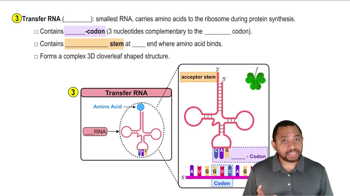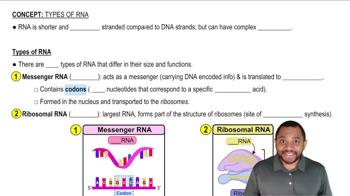Here are the essential concepts you must grasp in order to answer the question correctly.
tRNA (Transfer RNA)
tRNA is a small RNA molecule, typically about 76 to 90 nucleotides long, that plays a crucial role in protein synthesis. It carries amino acids to the ribosome, where proteins are assembled, and has an anticodon that pairs with the corresponding codon on mRNA. Its relatively small size compared to other RNA and DNA types makes it the shortest among the three.
Recommended video:
mRNA (Messenger RNA)
mRNA is a single-stranded RNA molecule that conveys genetic information from DNA to the ribosome, where proteins are synthesized. It is generally longer than tRNA, ranging from hundreds to thousands of nucleotides, depending on the gene being expressed. mRNA serves as a template for translation, making it larger than tRNA but smaller than DNA.
Recommended video:
DNA (Deoxyribonucleic Acid)
DNA is a double-stranded molecule that contains the genetic blueprint for all living organisms. It is composed of long chains of nucleotides, with a typical length of millions of base pairs, making it the largest of the three types of nucleic acids. DNA's structure allows it to store and transmit genetic information, which is essential for growth, development, and reproduction.
Recommended video:
Steps of DNA Replication Concept 1
 Verified step by step guidance
Verified step by step guidance Verified video answer for a similar problem:
Verified video answer for a similar problem:



 2:43m
2:43m